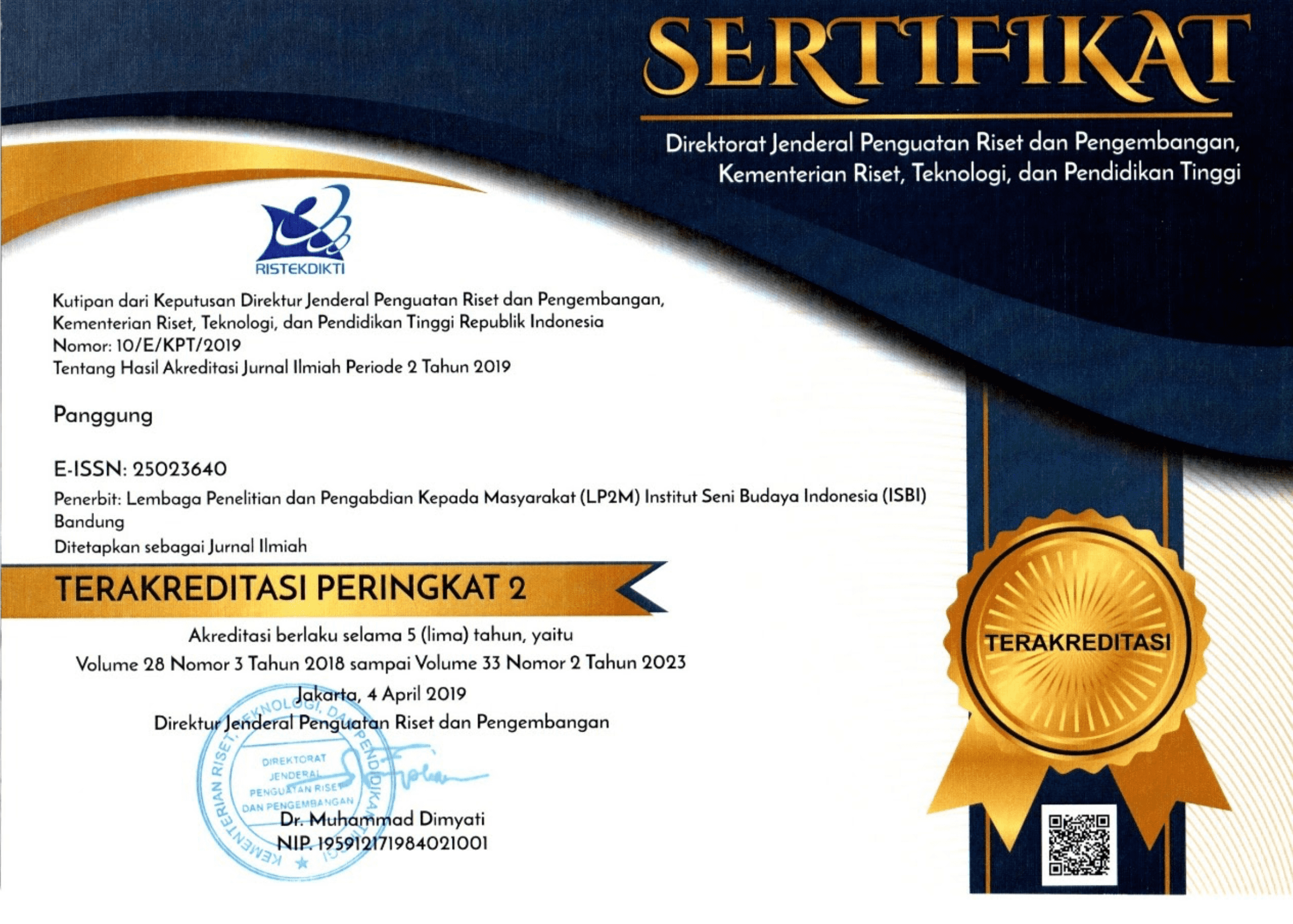Fungsi dan Makna Desain Karakter Wayang Potehi Lakon Shi Jhin Kwie
DOI:
https://doi.org/10.26742/panggung.v30i1.728Abstract
The object of this research is to analyze the functions and meanings of the characters of Wayang Potehi or Potehi puppet by taking the play of Shi Jin Kwie. The play is a popular fiction story which was later adapted into the story of Prabu Lisanpuro in Javanese theater (ketoprak). The results of the research found the organology structure of Wayang Potehi. It consists of 2, namely (1) parts of the body; head, hand, feet, and (2) clothing; along with ornaments and additional accessories such as swords and hats. The head section can be identified as the interpretation of the puppet character. For instance, an antagonist character depicted as if he was using a Balinese leak mask with his mouth open and angry. The clothes could be the interpretation of social status. For example, the villagers wear plain clothes without ornaments, while the nobles use yellow, red clothing with a dragon/ phoenix pattern. There are 4 types of character design in this show, specifically (1) the firm/ wise character, (2) the entertaining character, (3) the functionaries/ officials/ priyayi character, (4) the antagonist character. Especially for entertaining characters, it has a dual function; to return the underlying causes of the story and become the spy of the enemy. The methods used in this research are personality theory and functional theory approaches.
Keywords: potehi character design, Shi Jin Kwie, Function of potehi
References
Daftar Pustaka
Danandjaja, James. 1994. Antropologi
Psikologi. Jakarta: PT Raja Grafindo
Persada.
Eberhard, Wolfram. 1993. a Dictionary of
Cinese Symbol : Hidden Symbol in
Chinese Life and Thought. New York:
Roudledge
Hadi, Y. Sumandiyo. 2006. Seni dalam Ritual
Agama. Yogyakarta: Buku Pustaka.
Hall, Calvin S. 1981. Theories of Personality.
New York: John Wiley & Sons Inc.
Liliweri, Alo. 2003. Dasar-dasar Komunikasi
Antar Budaya. Yogyakarta: Media
Abadi.
Lorand, Ruth. 1994. Beauty and its Opposites:
Art and Criticism. Fall.
Mark, Dieter. 2004. Musik Kontemporer dan
Persoalan Interkultural. Bandung:
ARTI.
. 2007. Sejarah Musik Jilid 4. Yogyakarta:
Pusat Musik Liturgi.
Morgan, Harry T. 2007. China: Simbol dan
Mistik. Yogyakarta: Alfamedia.
Murgiyanto, Sal. 2002. Kritik Tari: Bekal dan
Kemampuan Dasar. Jakarta: MSPI.
Nakagawa, Sign. 2000. Musik dan Kosmos:
Sebuah Pengantar Etnomusikologi.
Jakarta: Yayasan Obor.
Purwanta, H. 2009. Sejarah Cina Klasik.
Yogyakarta: Universitas Sanata
Dharma.
Prier, Karl Edmund. 2002. Sejarah Musik Jilid
Yogyakarta: Pusat Musik Liturgi.
Riyanto, Bedjo dan Sayid Mataram. (2018).
Perkembangan Wayang Alternatif
di bawah Hegemoni wayang Kulit
Purwa. Panggung, 28 (1), 1-15.
Salim, Djohan. 2005. Psikologi Musik.
Yogyakarta: Buku Baik.
Schechener, Richard. 2006. Performance
Studies: an Introduction, second
edition. Inggris: Routledge.
Sutton, R. Anderson. 1991. Traditions of
Gamelan Music in Java: Musical
Pluralism and Regional Identity. New
York: Cambridge University Press.
Sunardi, Sugeng Nugroho dan Kuwato.
(2016). Pertunjukan Wayang Babad
Nusantara: Wahana Pengajaran Nilai
Kebangsaan Bagi Generasi Muda.
Panggung, 26 (2), 195-207.
Soedarsono, R.M. 2002. Seni Pertunjukan
Indonesia di Era Globalisasi.
Yogyakarta: Gadjah Mada University
Press.
. 2003. Seni Pertunjukan dari Perspektif Sosial
Politik dan Ekonomi. Yogyakarta:
Gadjah Mada University Press.
Tan, Melly G. 2008. Etnis Tionghoa di
Indonesia. Jakarta: Yayasan Obor.
Taniputera, Ivan. 2008. History of China.
Yogyakarta: Ar-Ruzz Media.
Toer, Pramoedya Ananta. 1998. Hoakiau di
Indonesia. Jakarta: Garba Budaya.
Website/laman
Wayang potehi: Bangkit dari Mati Suri
Makin digemari. Retrieved June
, 2012, from https://old.solopos.
com/2012/06/13/wayang-potehibangkit-
dari-
Downloads
Additional Files
Published
How to Cite
Issue
Section
Citation Check
License
Penulis yang menerbitkan jurnal ini menyetujui persyaratan berikut:
Penulis memiliki hak cipta dan memberikan jurnal hak publikasi pertama dengan karya yang secara simultan dilisensikan di bawah Creative Commons Attribution License yang memungkinkan orang lain untuk berbagi karya dengan pengakuan kepengarangan karya dan publikasi awal dalam jurnal ini.
Penulis dapat mengadakan perjanjian kontrak tambahan yang terpisah untuk distribusi non-eksklusif versi jurnal yang diterbitkan dari karya tersebut (misalnya, mempostingnya ke repositori institusional atau menerbitkannya dalam sebuah buku), dengan pengakuan atas publikasi awalnya dalam jurnal ini.
Penulis diizinkan dan didorong untuk memposting pekerjaan mereka secara online (mis., Dalam repositori institusional atau di situs web mereka) sebelum dan selama proses pengiriman, karena dapat menyebabkan pertukaran yang produktif, serta kutipan yang lebih awal dan lebih besar dari karya yang diterbitkan.
Authors who publish with this journal agree to the following terms:
Authors retain copyright and grant the journal right of first publication with the work simultaneously licensed under a Creative Commons Attribution License that allows others to share the work with an acknowledgement of the work's authorship and initial publication in this journal.
Authors are able to enter into separate, additional contractual arrangements for the non-exclusive distribution of the journal's published version of the work (e.g., post it to an institutional repository or publish it in a book), with an acknowledgement of its initial publication in this journal.
Authors are permitted and encouraged to post their work online (e.g., in institutional repositories or on their website) prior to and during the submission process, as it can lead to productive exchanges, as well as earlier and greater citation of published work.





